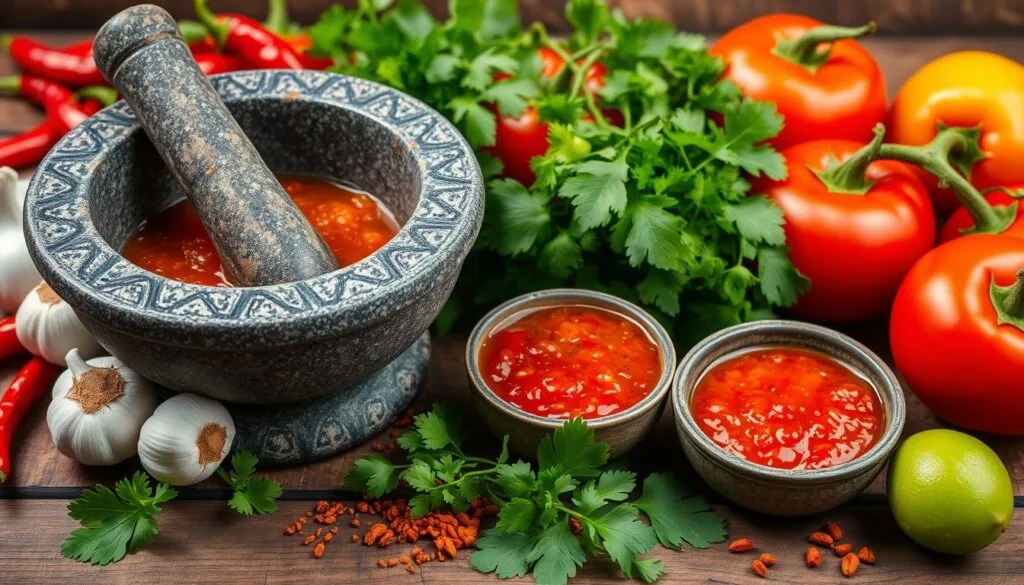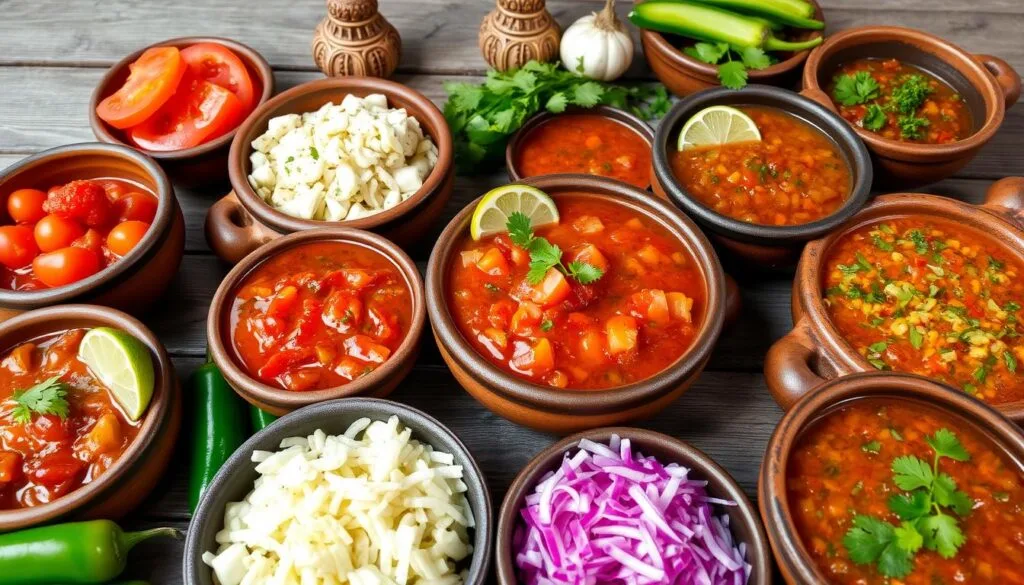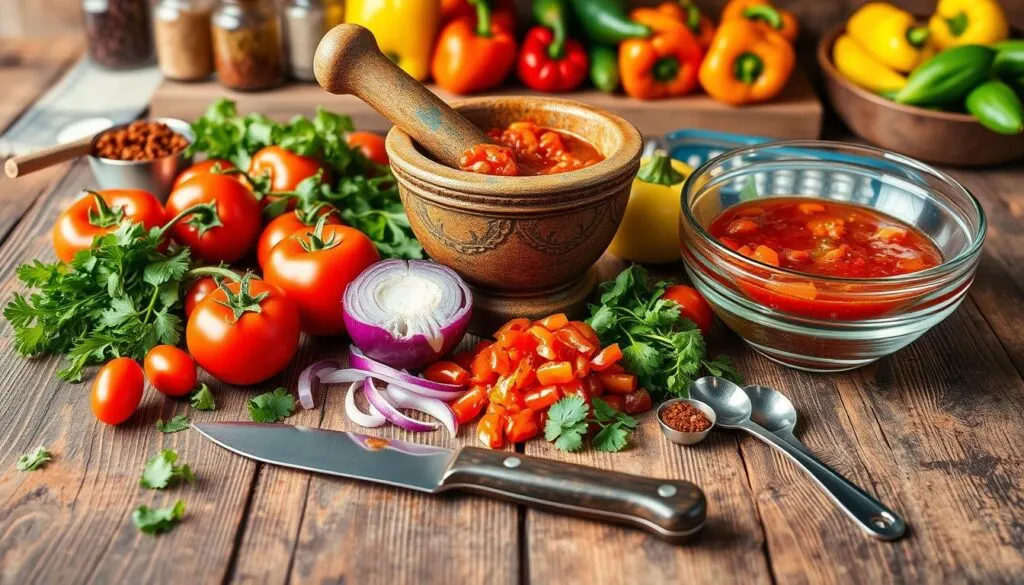I’m proud to share my Mexican-American heritage with you. The smell of roasted chili peppers and the tang of tomatillos always brings me comfort. I’m excited to share a real Mexican hot sauce recipe with you.
Making homemade salsa might seem hard, but it’s easy and quick. It only takes 20 minutes. With the right ingredients and techniques, you can taste Mexico in your kitchen. Get ready for a spicy adventure.

Key Takeaways
- Discover an authentic Mexican hot sauce recipe that captures the essence of traditional Mexican cuisine.
- Learn the significance of regional variations and key authentic ingredients in Mexican salsas.
- Understand the essential equipment and tools needed to make homemade salsa with ease.
- Explore the freshest produce selection tips for creating the perfect hot sauce.
- Master the step-by-step instructions for making your own authentic Mexican hot sauce.
What Makes Mexican Hot Sauce Authentically Traditional
In the world of Mexican cuisine, the charm of Mexican hot sauce and salsa recipes comes from their long-standing traditions. These spicy sauces are more than just flavor boosters. They are a symbol of Mexico’s rich cultural history.
Regional Variations and Their Unique Characteristics
The Salsa Roja from central Mexico is smoky and earthy. The Salsa Verde from the coast is bright and tangy. Each Mexican hot sauce reflects the unique tastes of its area. The choice of chili peppers, indigenous spices, and family recipes all play a part.
Key Authentic Ingredients in Mexican Salsas
- A wide range of chili peppers, like ancho and habanero, add their own heat and taste
- Fresh tomatoes balance sweetness and acidity
- Crisp onions add depth and complexity
- Fragrant garlic enhances the flavor
- Fresh cilantro brings a herbaceous note
The secret to real Mexican hot sauce is using the best, locally-sourced ingredients. This focus on quality and freshness makes these spicy salsa recipes stand out. They offer a true taste of Mexico’s culinary traditions.

Essential Equipment and Tools for Making Homemade Salsa
Making a real Mexican homemade hot sauce or mexican hot sauce recipe needs some key tools. You’ll need the right blender or food processor and a perfect roasting pan. The right tools can change the taste and texture of your salsa.
A strong blender or food processor is crucial. It makes your salsa smooth and creamy, just like traditional Mexican salsas. Choose one with different speed settings for both chunky and smooth textures.
A good roasting pan or sheet is also essential. Here, you roast tomatoes, onions, and peppers to get their smoky flavors. A heavy, oven-safe pan ensures even heat and prevents burning.
- Sharp chef’s knife for precise chopping and dicing
- Sturdy cutting board to provide a stable surface for your prep work
- Airtight storage containers to preserve your fresh salsa
| Tool | Purpose | Alternatives |
|---|---|---|
| Blender or Food Processor | Achieve the desired texture, from chunky to smooth | Immersion blender, manual food chopper |
| Roasting Pan | Char and roast ingredients for enhanced flavor | Cast-iron skillet, baking sheet |
| Chef’s Knife | Precise chopping and dicing of fresh produce | Serrated knife, paring knife |
| Cutting Board | Provide a stable surface for food preparation | Wooden board, plastic board |
| Storage Containers | Preserve and store the freshly made salsa | Mason jars, airtight glass or plastic containers |
With these tools and a little practice, you’ll make the perfect homemade hot sauce or mexican hot sauce recipe. It will take you straight to Mexico with every bite.

Fresh Ingredients Selection Guide for Perfect Hot Sauce
Making a real Mexican hot sauce needs careful picking of fresh, top-notch ingredients. You’ll need the right peppers, ripe tomatoes, and fragrant produce. Each part is key to making a tasty and balanced salsa. Let’s look at how to pick the best ingredients for your homemade chili pepper salsa, habanero hot sauce, or jalapeño salsa.
Choosing the Right Peppers for Your Heat Level
The core of any Mexican hot sauce is the peppers. You can find peppers for any heat level you like. For a milder taste, try jalapeños. They give a nice, slightly spicy flavor.
If you want something bolder, habaneros are perfect. They add a fruity, intense heat. Mix different peppers to get the heat just right for you.
Tomato Selection Tips
Good tomatoes are essential for a vibrant hot sauce. Choose tomatoes that are ripe, juicy, and have a deep color. Roma or plum tomatoes work well because they have more flesh than seeds.
Stay away from overripe or watery tomatoes. They can make your hot sauce taste weak.
Additional Produce and Aromatics
- Onions: Red or white onions add a sweet, pungent note that balances the heat of the peppers.
- Garlic: Fresh, minced garlic enhances the depth of flavor and aroma in your hot sauce.
- Cilantro: This fragrant herb lends a signature freshness and brightness to traditional Mexican salsas.
- Lime juice: A squeeze of fresh lime juice adds a tangy, citrusy element that brightens the overall profile.
By picking the right peppers, tomatoes, and aromatics, you’re on your way to making a delicious Mexican hot sauce. It will surely please your taste buds.
Mexican Hot Sauce Recipe: Step-by-Step Instructions
Making your own mexican hot sauce recipe is a fun cooking journey. Follow these steps to make a lively, tasty homemade hot sauce. It will take you straight to the heart of Mexico.
- First, get your ingredients ready. You’ll need fresh chili peppers (like jalapeños or serranos), tomatoes, onions, garlic, cilantro, lime juice, and salt.
- Next, roast the chili peppers until they smell smoky. You can do this on a hot comal or in the oven. This step makes your spicy salsa recipe even more flavorful.
- After roasting, peel and seed the peppers. Then, chop them up with the tomatoes, onions, and garlic.
- In a blender or food processor, mix the chopped ingredients with cilantro, lime juice, and a bit of salt. Blend until it’s the right consistency. You want it smooth but still a bit chunky for that authentic Mexican touch.
- Try your hot sauce and see if it needs more lime juice or a bit of honey. This will help balance the flavors.
The secret to a great mexican hot sauce recipe is finding the right mix of heat, tanginess, and freshness. With these easy steps, you’ll make a hot sauce that everyone will love. Your family and friends will be impressed by your cooking skills.
Roasting and Charring Techniques for Enhanced Flavor
Authentic Mexican cuisine is known for its bold flavors. Traditional Mexican recipes often use special techniques to boost taste. Roasting and charring ingredients can make a big difference in homemade hot sauce or salsa.
Traditional Comal Method
In Mexican cuisine, the comal method is a classic. A comal is a flat griddle, usually made of cast iron or clay. It’s used for toasting spices and grilling tortillas, adding a smoky flavor.
By controlling the heat and turning the ingredients, you get a charred outside and a juicy inside. This method is key to achieving the right flavor.
Modern Oven Roasting Approach
If you don’t have a comal, oven roasting is a great alternative. Place ingredients like tomatoes, onions, and peppers on a baking sheet. Roast them at high heat to get a caramelized, smoky taste.
It’s important to watch the ingredients closely. Turn them now and then for even charring. This method can still bring out the rich flavors of Mexican hot sauce or salsa.
Roasting and charring are essential for unlocking deep flavors in your Mexican cuisine. The mix of sweet, savory, and smoky notes makes your dish truly authentic.
Blending and Consistency Tips for Perfect Texture
Getting the right texture for your homemade hot sauce or spicy salsa is key. It’s all about blending techniques. You can aim for a smooth, creamy or a chunkier, rustic texture, depending on what you like.
Think about the ingredients you use. More tomatoes and onions make a thicker salsa. More peppers and garlic make it smoother. Try different mixes to get the texture you want.
Blend slowly and in batches if needed. Use a strong blender or food processor. Pulse the mix until it’s smooth but not too thin. Over-blending can make it watery and unpleasant.
| Blending Technique | Texture Result |
|---|---|
| Pulse blending | Chunky, rustic salsa |
| Continuous blending | Smooth, creamy hot sauce |
For a chunky, authentic Mexican-style salsa, pulse the blender. This keeps some ingredients chunky. For a smooth hot sauce, blend continuously until it’s silky.
“The key to perfect salsa or hot sauce texture is understanding how the blending process impacts the final product. With a little experimentation, you can find the right balance to suit your taste buds.”
The texture of your Mexican dishes is up to you. Enjoy trying different blends and mixes. You’ll find your perfect homemade hot sauce or spicy salsa recipe.
Storage and Preservation Methods
Keeping your homemade mexican hot sauce recipe fresh is key. The right storage and preservation methods help your homemade hot sauce stay good for weeks. This way, you can enjoy its true Mexican taste for a long time.
Proper Container Selection
Choosing the right container is essential. Use airtight glass jars or BPA-free plastic containers to keep it fresh. Metal containers are a no-go because they can change the taste of your hot sauce.
Shelf Life Guidelines
- Refrigerated homemade hot sauce: Keeps for 2-3 weeks in the fridge.
- Frozen mexican hot sauce recipe: Freezes for up to 6 months, but the texture might change.
- Shelf-stable (room temperature): If sealed well and stored in a cool, dark spot, it lasts up to 1 year.
The shelf life can change based on your mexican hot sauce recipe. Always check for spoilage signs like bad smells or mold before using.
By following these tips, you can enjoy your homemade mexican hot sauce recipe for a long time. Use it on everything from classic Mexican dishes to new recipes.
Spice Level Customization and Heat Control
Making the perfect chili pepper salsa, habanero hot sauce, or jalapeño salsa is all about finding the right balance. You might want a mild dip or a hot condiment. Knowing how to adjust the spice level is key.
The type and amount of peppers used greatly affect the heat. Jalapeños give a moderate kick, while habaneros and other hot peppers are much spicier. By changing the pepper mix, you can adjust the spiciness to your liking.
- For a milder salsa, use more mild peppers like Anaheim or Cubanelle and less hot ones.
- For a spicier salsa, add more habaneros, serranos, or Thai chilis.
- Pepper seeds and membranes have the most capsaicin, so removing them can reduce the heat.
If your salsa is too spicy, don’t worry. You can balance it by adding more tomatoes, onions, or garlic. Or, a bit of sour cream or avocado can help cool it down.
| Pepper Type | Scoville Heat Units (SHU) | Heat Level |
|---|---|---|
| Anaheim | 500-2,500 SHU | Mild |
| Jalapeño | 2,500-8,000 SHU | Medium |
| Serrano | 10,000-23,000 SHU | Hot |
| Habanero | 100,000-350,000 SHU | Extremely Hot |
By knowing the heat levels of different peppers and experimenting, you can make chili pepper salsa, habanero hot sauce, and jalapeño salsa just right. Enjoy the art of customization and let your taste guide you!
Serving Suggestions and Traditional Pairings
Authentic Mexican cuisine shines when paired with the right homemade hot sauce. Whether you’re making a classic dish or trying something new, this vibrant condiment can make any meal better.
Popular Mexican Dishes to Complement
Tacos, enchiladas, and quesadillas are favorites in Mexican cuisine. Your homemade red salsa or green salsa can make them even more delicious. Try drizzling it over shredded chicken or beef for extra flavor. Or, use it as a sauce for fried tortilla chips.
Creative Modern Applications
- Add a dollop of hot sauce to your favorite avocado toast or scrambled eggs for breakfast.
- Use the bold flavors of your authentic Mexican recipes in dishes like grilled salmon or roasted vegetables.
- Try using your homemade salsa as a marinade or glaze for meats. It adds color and heat.
| Traditional Pairing | Modern Twist |
|---|---|
| Tacos | Grilled Shrimp Tostadas |
| Enchiladas | Salsa-Stuffed Chicken Breasts |
| Nachos | Salsa-Drizzled Roasted Vegetables |
There are countless ways to use your homemade Mexican hot sauce and authentic Mexican recipes. Try different flavors and traditions to find your new favorite way to enjoy this versatile condiment.
Common Mistakes to Avoid When Making Hot Sauce
Making the perfect Mexican hot sauce recipe at home needs careful attention. Stay away from these common mistakes to make sure your homemade hot sauce is always tasty and consistent.
- Failing to balance the pepper-to-tomato ratio: An imbalance can result in a sauce that’s overly spicy or lacks depth of flavor.
- Overcooking the ingredients: Proper roasting and charring techniques are crucial, but going too far can lead to bitterness.
- Neglecting to properly blend the sauce: Inconsistent texture and separation can occur without sufficient blending.
- Skimping on essential aromatics: Key ingredients like onions, garlic, and herbs lend vital complexity to the final product.
- Inadequate seasoning: Proper salting and adjusting the acidity are essential for a well-balanced homemade hot sauce.
By avoiding these mistakes and following best practices, you can make an authentic Mexican hot sauce. It will be full of flavor and tailored to your taste.
“The secret to a great homemade hot sauce is finding the right balance of ingredients and techniques.”
With a bit of care and attention, you can become a pro at making Mexican hot sauce at home. Enjoy the journey, try out different peppers and flavors, and savor the delicious outcomes.
Conclusion
In this guide, you’ve learned how to make Mexican hot sauce at home. You now know about the different types and what ingredients to use. You also know how to roast and blend them.
Creating your own salsa is more than just making food. It’s about using fresh ingredients and trying new flavors. This lets you connect with Mexico’s rich food traditions. So, keep trying new things and making your homemade hot sauce your own.
Making Mexican cuisine at home means you can choose what goes into it. You can control the spice and how authentic it is. With this guide, you can enjoy Mexico’s flavors in your own kitchen. Let your creativity shine with every batch of hot sauce you make.
Related : Delicious Crab brulee Recipe: A Luxurious Seafood Treat
FAQ
What are the key ingredients in authentic Mexican hot sauce?
Authentic Mexican hot sauce includes chili peppers like jalapeños and habaneros. It also has tomatoes, onions, garlic, and cilantro. The exact mix can change based on where you are and what you like.
How do I choose the right peppers for my desired heat level?
Pick peppers based on the Scoville scale for heat. Jalapeños are mild, while habaneros are hot. Mix different peppers to get the heat you want.
What is the best way to roast the peppers and other ingredients?
Roasting on a comal or in the oven brings out great flavor. For a comal, use a hot skillet. For the oven, spread ingredients on a baking sheet and roast until fragrant.
How do I adjust the consistency of my homemade Mexican hot sauce?
Change the sauce’s texture by how you blend it. For a smooth sauce, blend well. For a chunky one, pulse the ingredients a bit.
How long does homemade Mexican hot sauce last, and how should I store it?
Homemade hot sauce lasts up to 1 week in the fridge or 3 months in the freezer. Keep it in an airtight glass or plastic container to stay fresh.
How can I customize the spice level of my Mexican hot sauce?
To change the heat, adjust the pepper mix. Use more mild peppers for a milder sauce. Add hot peppers for more heat. You can also change the amount of peppers.
What are some traditional Mexican dishes that pair well with homemade hot sauce?
Homemade hot sauce is great with tacos, enchiladas, and burritos. It’s also good with quesadillas, nachos, and as a dip for tostadas and empanadas. Use it on eggs, rice, and beans too.
